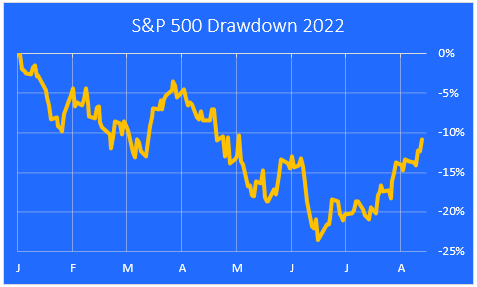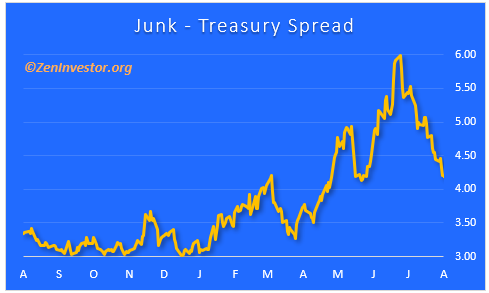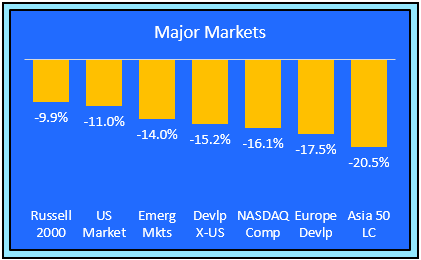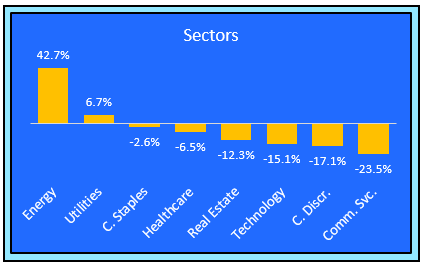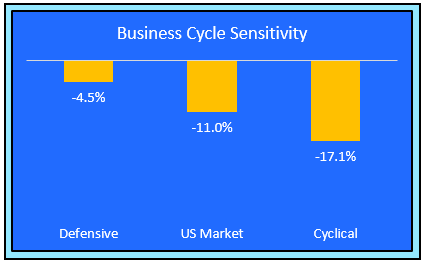Market Recap - Follow the Money is a series of brief, information-rich posts that I will publish periodically but not on a fixed schedule. I rely on charts to do the heavy lifting and I keep my commentary to a minimum.
If you're like me, you prefer to visualize facts and figures rather than reading about them in a long article. That's why I use charts and tables instead of dull, tedious prose. I also like to keep things as simple and on-point as possible.
Chart 1. Getting close to a new bull market
After declining by 23% as of June 16, the market has flipped into hyperdrive. For a time it looked as if the dip-buyers had given up and the rally-sellers were squashing any attempts to move higher. Now the tide has turned and the dip-buyers look unstoppable.
At Friday's close of 4280, the S&P 500 is now within 120 points of exiting this bear market. 4400 would mark a 20% rise from the June low of 3666. Momentum is clearly higher, and if we reach 4400 it will be hard, but not impossible, to go back and take out the old cycle low.
Chart 2. Confirmation from the junk bond market.
In June, junk bond buyers were demanding a 6% premium over Treasuries as they worried about a tidal wave of defaults. That didn't happen, and the spread has been halved since then. Bond buyers are confirming the risk-on attitude of equity traders.
Chart 3. Major Markets
I divide the global equity market into 7 segments - U.S. Total Market, U.S. Small Cap, NASDAQ, Foreign Developed, Europe Developed, Asia Large Cap. and Emerging Markets. As with all the charts, I show the year-to-date return. You can follow the money as it moves among these seven market segments.
Small caps, as represented by the Russell 2000 index, have taken the lead after falling behind earlier in the year. NASDAQ is making a strong comeback as the beaten-down tech sector has come back to life.
Asia large caps are still struggling as China's woes continue to weigh on the Asia 50 index.
Chart 4. Market Sectors
Of the eleven primary market sectors, this chart shows the top four and bottom four performers. Money has been flowing out of tech, consumer discretionary, and communications services, and into energy, utilities, and consumer staples.
These trends will probably continue as long as there is uncertainty caused by the Russia-Ukraine war. Demand for oil & gas remains high, the global economy is taking a hit to growth. and inflation will continue tp be a problem until the Fed gets control of it.
Chart 5. Industries
Of the 60 industry groups tracked by S&P Global Markets, I highlight the top three and bottom four to keep this chart simple. The chart speaks for itself.
Chart 6. Styles - Growth vs. Value
After slightly underperforming growth last year, value is where the money is flowing. I see this as another durable trend. Growth has been hit hard by the slide in tech stocks this year. But growth is gaining ground during this rally, rising twice as fast as value.
Chart 7. Size
Small caps have overtaken large caps for the first time this year. Mid caps were almost tied with large caps last year, and the are in the lead this year. The flow of money into mid caps looks like a durable trend.
Chart 8. Factors
There are more than 100 factors to choose from, so I had to cut the list to just six, in order to keep this chart reasonably easy to digest. The quality factor is getting pummeled this year after a solid showing 2021.
The top performing factor so far is dividend yield. I'm not sure about the durability of this trend, because higher bond interest rates will begin to compete with dividends at some point.
Chart 9. Sensitivity to the business cycle
In this chart I divided the market sectors into two groups - those that respond more vigorously to the changing phases of the business cycle (cyclical), and those that respond less vigorously (defensive).
With the economy still in growth mode, cyclical stocks should do better than defensive stocks. That hasn't happened yet this year, and maybe the market is sending a signal that the economy isn't as strong as many would like to believe.
The flow of money away from cyclicals and into defensive looks durable.
Chart 10. Bonds
It's interesting to watch how the various flavors of bonds react to Quantitative Tightening. So far it looks like Treasury bonds are seeing the most outflows. That's understandable, given the sharp rise in the 2-yr and 10-yr rates.
Keep an eye on junk bonds, because they are especially vulnerable to an economic slowdown. If they continue to gain momentum, the risk of recession decreases.
Chart 11. Countries
There are 50 countries that are represented by ETFs. Here are the top and bottom performers YTD. South America is having a resurgence this year, while Europe is struggling with geopolitical issues and heavy sanctions - both imposed and threatened.
Final thoughts
The trends we have established thus far will probably continue as long as the war, and all the uncertainty it brings with it, remains in place. By keeping an eye on money flows among these asset categories, you can gain some insight into what could be a durable trend, and what's just noise.
The trends that look the most durable to me at this time are value vs. growth, mid cap vs. large and small cap, defensive vs. cyclical, and commodities - especially energy - vs. tech.
European and Asian economies seem more vulnerable to the fallout from sanctions against Russia. There is a chance that Europe may slip into a recession later this year, and some Asian countries may follow after that.
The US will likely avoid a recession this year, but the picture may change in 2023. The major Wall Street strategists have been reducing their price targets for year-end, with an average of 4400 for the S&P 500.
As the late Marty Zweig used to say, don't fight the tape and don't fight the Fed. The tape has been very strong lately but the Fed appears to be firmly committed to bringing inflation under control. If the market flips from bear to bull, it behooves investors to pick their spots carefully. That's why I like to follow the money.

